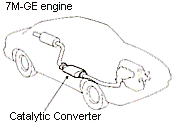| CAUTION:
- Avoid inhaling the exhaust. It contains carbon monoxide, which is a colorless and odorless gas. It can cause unconsciousness or even death.
- Make sure the exhaust system has no holes or loose connections. The system should be checked from time to time. If you hit something, or notice a change in the sound of the exhaust, have the system checked immediately.
- Do not run the engine in a garage or enclosed area except for the time needed to drive the vehivle in or out. The exhaust gasses cannot escape, making this a particularly dangerous situation.
- Do not remain for a long time in a parked vehicle with the engine running. If it unavoidable, however, do so only in an unconfined area and adjust the heating or cooling system to force outside air into the vehicle.
- Keep the trunk lid, back door or tailgate closed while driving. An open or unsealed trunk lid, back door or tailgate may cause exhaust gases to be drawn into the vehicle. If you must drive with the trunk lid, back door or tailgate open to accommodate a large object, close the windows, open all the dashboard vents and have the heating or cooling system deliver fresh air into the vehicle by turning the fan to high speed with the air intake control button set in the OUTSIDE AIR mode.
- To allow proper operation of your vehicle's ventilation system, keep the inlet grilles in front of the winshield clear of snow, leaves or other obstructions.
- If you semll exhaust fumes in the vehicle, drive with the windows open and the trunk lid, back door or tailgate closed. Have the cause immediately located and corrected.
|

